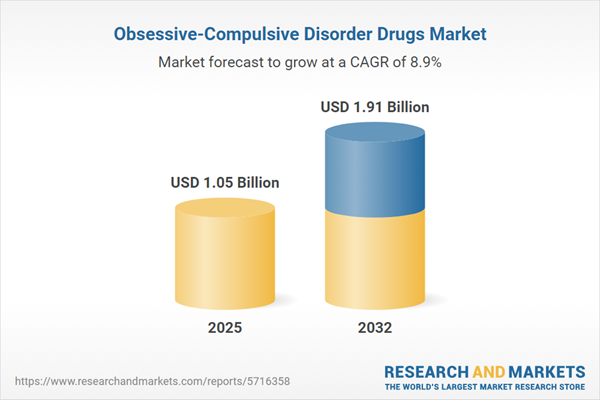Speak directly to the analyst to clarify any post sales queries you may have.
The obsessive-compulsive disorder drugs market is evolving in response to regulatory shifts, advancing digital technologies, and growing patient expectations. Senior decision-makers are aligning technology adoption with patient-centered strategies to deliver value and maintain market relevance.
Market Snapshot: Obsessive-Compulsive Disorder Drugs Market
The obsessive-compulsive disorder drugs market is witnessing steady growth as a result of increased disorder awareness and improved diagnostic capabilities. New pharmacological treatments and the adoption of digital health tools are enhancing patient adherence and outcomes. Both mature and emerging regions are updating regulatory frameworks, impacting how drugs are approved and distributed. Key industry players are prioritizing rapid drug development, cross-sector partnerships, and innovative delivery systems to stay competitive. Leaders must leverage these advancements and monitor policy changes to respond effectively to evolving clinical practices and industry challenges.
Scope & Segmentation of the Obsessive-Compulsive Disorder Drugs Market
- Drug Classes: Monoamine oxidase inhibitors, serotonin-norepinephrine reuptake inhibitors, selective serotonin reuptake inhibitors, and tricyclic antidepressants all play a vital role in providing tailored treatments and improving overall patient management strategies.
- Distribution Channels: Hospital pharmacies, retail pharmacies, and online platforms are key to therapy access and helping organizations expand their regional presence in diverse healthcare settings.
- Drug Types: Branded and generic pharmaceuticals allow organizations to refine procurement approaches, adapt to payer demands, and address cost pressures across multiple markets.
- Route of Administration: Oral and parenteral options support personalized care, enabling providers to match drug delivery with patient requirements and established clinical protocols.
- End Users: Clinics, hospitals, and home care environments facilitate a broad spectrum of delivery models and promote collaboration among multidisciplinary medical teams for acute and ongoing therapy management.
- Patient Age Groups: Adult and pediatric populations are targeted through distinct protocols, assisting providers in delivering precise, age-appropriate care along the treatment continuum.
- Regional Coverage: The market analysis considers the Americas, Europe, Middle East & Africa, and Asia-Pacific, reflecting the impact of local regulatory requirements, compliance obligations, and competitive market dynamics unique to each geography.
- Company Coverage: Industry leaders including Pfizer Inc., Eli Lilly and Company, GlaxoSmithKline plc, H. Lundbeck A/S, Teva Pharmaceutical Industries Ltd., Novartis AG, Sun Pharmaceutical Industries Ltd., Viatris Inc., Otsuka Pharmaceutical Co., Ltd., and Johnson & Johnson support therapy diversity, research advancements, and product innovation.
Key Takeaways for Senior Decision-Makers
- Rapid uptake of innovative pharmacological mechanisms and flexible drug delivery methods supports adaptation to emerging clinical standards and evolving patient profiles.
- Strategic investments in digital health and patient-centered initiatives improve engagement, enhance medication adherence, and facilitate more personalized management approaches.
- A balanced portfolio of branded and generic drugs enables organizations to optimize procurement, strengthen negotiation positions with payers, and foster operational flexibility.
- Embracing digital platforms, such as telemedicine and remote monitoring, extends service to underserved populations and streamlines access in areas with limited healthcare facilities.
- Robust supply chain management, backed by digital oversight tools, is essential for minimizing regulatory disruptions and maintaining reliable product availability for patients and providers.
- Operational agility combined with effective risk management ensures organizations are equipped to navigate fluctuations in both regulatory and logistical conditions.
Tariff Impact and Supply Chain Adjustments
New U.S. tariffs on imported active pharmaceutical ingredients are prompting companies to reevaluate supply chain frameworks. Many organizations are adopting domestic sourcing strategies and nearshoring to address potential disruption risks. Procurement processes at hospitals and retail channels are adapting to safeguard continuity, while digital logistics solutions enhance real-time oversight. These changes are critical for ensuring uninterrupted patient treatment and operational stability in a complex regulatory setting.
Methodology & Data Sources
This market research report uses a comprehensive mixed-methods model, incorporating direct industry interviews, systematic literature reviews, regulatory analysis, and quantitative data modeling. The approach helps deliver credible, actionable insights for evidence-based leadership decisions.
Why This Report Matters
- Prepares executive teams to incorporate technological and regulatory developments into growth-focused strategies while supporting compliance objectives.
- Provides detailed segmentation and competitive analysis that support expansion and operational efficiency across varied global markets.
- Guides leaders in responding to changes in reimbursement policies and in building agile supply chains that meet dynamic sector requirements.
Conclusion
To achieve consistent performance and improve patient outcomes in the obsessive-compulsive disorder drugs market, organizations need adaptive leadership, strong regulatory awareness, and strategic application of emerging technologies.
Additional Product Information:
- Purchase of this report includes 1 year online access with quarterly updates.
- This report can be updated on request. Please contact our Customer Experience team using the Ask a Question widget on our website.
Table of Contents
3. Executive Summary
4. Market Overview
7. Cumulative Impact of Artificial Intelligence 2025
Companies Mentioned
The companies profiled in this Obsessive-Compulsive Disorder Drugs market report include:- Pfizer Inc.
- Eli Lilly and Company
- GlaxoSmithKline plc
- H. Lundbeck A/S
- Teva Pharmaceutical Industries Ltd.
- Novartis AG
- Sun Pharmaceutical Industries Ltd.
- Viatris Inc.
- Otsuka Pharmaceutical Co., Ltd.
- Johnson & Johnson
Table Information
| Report Attribute | Details |
|---|---|
| No. of Pages | 181 |
| Published | October 2025 |
| Forecast Period | 2025 - 2032 |
| Estimated Market Value ( USD | $ 1.05 Billion |
| Forecasted Market Value ( USD | $ 1.91 Billion |
| Compound Annual Growth Rate | 8.8% |
| Regions Covered | Global |
| No. of Companies Mentioned | 11 |









